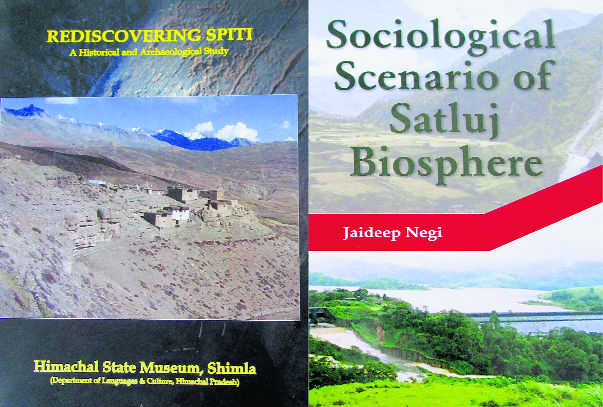A journey to Spiti and Sutlej biosphere
Shriniwas Joshi
Abook is a portable magic. There were two magicians — Dr Hari Chauhan and Dr Jaideep Negi — with me in the past few days, who weaved such a web around me that I voluntarily remained ensnared in it. Hari Chauhan, who is curator in the Himachal State Museum, Shimla, edited an engrossing book 'Rediscovering Spiti'. Published by the State Museum, Shimla, it has 10 chapters each written by archaeologists of repute and costs Rs 800.
Lahaul and Spiti were formed as one unit in 1941 by the British. It was declared as a district in 1960. Michael Dowad and Tsering Norbu in their article state: "Spiti and Lahaul are two significantly different places. Perhaps the most obvious cultural distinction is that Spiti has traditional Tibetan Buddhism and Lahaul has a mix of Tibetan Buddhism and Hinduism."
Spiti is a cold desert. The Great Himalayan range blocks most of the monsoon. Farming is almost entirely dependent on snowmelt and from the possible irrigation from River Spiti. Wild onion and sea buckthorn are collected by Spitians for their food besides smoked meat during the winter season. The book also speaks of the wildlife in Spiti that is different from the neighbouring Ladakh and Western Tibet.
The book takes us to a journey of Spiti to show us petroglyphs (rock carvings) and pictographs (rock paintings). There are four known sites of ancient petroglyphs in northwest Spiti — three at or near Kunzum La and one at Rongtong near Rangrik. Animals are the most recognisable subject of Spiti art, with bharal (blue sheep), ibex and drong (wild yak) as the models. Horse depicting authority has also been sketched frequently. There is a whole chapter on 'the horse and rider on the rock drawings of Spiti' by Maheshwar P Joshi in the book.
Hari Chauhan and his associates mention: "The most important discovery in the Spiti valley is a prehistoric camp-cum-factory site of Dzama Thang, where a large number of lithic (pertaining to stone) tools and debitage (waste material produced after making prehistoric stone implements) were found. Dzama Thang site is situated on the left bank of River Spiti."
The book has come out under a scheme, whereby the Himachal State Museum, Shimla, in collaboration with HIMSAR and Rock Art Society, Kaza, organised a two-day seminar-cum-site-seeing programme on the rock art of Spiti. The seminar was presided over by Phunchog Rai, who was a former minister in Himachal. He belongs to Spiti. In the presidential address, he gave the meaning of certain symbolic gifts that people exchange, e.g. a plant 'tse' depicts sadness; a match box as gift shows heart-burning; a plant 'dama' portrays remembrance, while 'moonga' symbolises suffering from hypertension and 'kaudi' or shell signifies confusion and many more examples.
Mark Aldenderfer, professor at University of California, writes in his foreword of the book: "Rupestral (art on rocks) provides yet another important window on connections across the region. Spiti has a tremendously rich body of this art that is under constant threat from construction and neglect." The journey of Spiti art work through this book is so absorbing that one does not feel worn out.
Dr Jaideep Negi is the chief librarian at the HP secretariat library. His book 'Sociological Scenario of Satluj Biosphere' is published by Shubhi Publications, Gurugram, and costs Rs 995. The Sutlej drainage system is central to the area of this study. Negi believes that River Sutlej is one of the important natural sources of power generation and also the harbinger of catastrophic miseries to people living on its banks. River Spiti joins Sutlej at Khab and the site of their confluence is called 'scene of awful sublimity' because both carry with their waters a lot of silt. At Karcham, River Baspa and at Wangtu, Bhaba River joins it. Nogli, Bharakhad and Kurpan Rivers make a bond with Sutlej, as it flows down. Negi has not mentioned the two marriages of Sutlej and Beas, an arranged one through man-made tunnel at Dehar in Sundernagar and the love marriage at Harike in Punjab. But he spoke of Sirsa River that flows from Nalagarh and meets Sutlej at Chakdehra in Punjab. After Physiography, the author has given in details the works done under horticulture, agriculture and in harnessing of forest resources that have affected the society of Sutlej biosphere.
In his view, the great thing that has happened is the prohibition of 'begar' (forced labour) since May 1948; the legislations like HP Abolition of Big Landed Estates, Land Reforms and HP Panchayati Raj Acts have transformed the villages into self-contained units. Traditional agriculture has been replaced by potato and apple economy. He wanted people to copy the example of the conservation of forests by Jakh Devta of Dodra village in Dodra-Kawar subdivision and Maheshwari Devi near Matiana in Shimla district. He is rightly concerned about the damaging effects of applied science on nature, environment and humanity, especially, public health. His message, in short, is — development is there but the human face is often missing.
Tailpiece
"So many books; so little time." — Frank Zappa









